| Home |
| Acknowledgments |
| Conventions |
| Glossary |
| Maps |
| References |
| Links |
| Articles |
| Thumbnails |
| Species
list |
| Family |
| Next
species |
Additional Photos

underside

parapodia
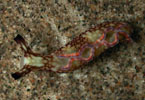
migratory form
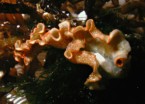
senescent?
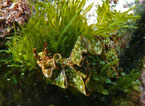
feeding
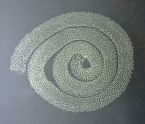
egg mass
_______________
GALLERY

Elysia rufescens (Pease, 1871)
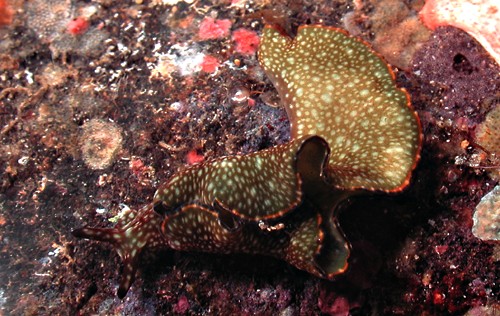
| Maximum size: 48 mm. Identification: This is a highly variable species with sedentary and migratory forms. The sedentary form has tall, thin parapodia containing elaborate ramifications of the digestive gland. The parapodia usually meet in a more or less continuous line without obvious chimneys and are olive-brown with closely spaced cream patches. There is a continuous violet-black marginal line and an orange submarginal line, both overridden by cream patches. The rhinophores are olive-brown with cream patches and violet-black tips. Occasional animals may lack most dark pigment, including the marginal black line (perhaps due to loss of chloroplasts with senescence?). (Note 1) The migratory form is usually smaller (seldom exceeding 33 mm) with lower and proportionately thicker parapodia that are typically held in three chimneys. Unlike in the sedentary form, they contain relatively few branches of the digestive gland but are otherwise similar in color. Some animals have a few small orange flecks on the interior of their parapodia. Occasionally, the violet-black marginal line may be absent. (Note 2) Natural history: The sedentary form of Elysia rufescens is commonly found in beds of the green algae Bryopsis, often occurring in mixed populations with the sedentary form of Elysia marginata. Such Bryopsis beds usually grow in highly protected to moderately exposed back reef locations at depths of < 1 m (< 3 ft). Mature animals show little change in behavior day or night. (Note 3) The migratory form is moderately common in moderately protected to moderately exposed rocky habitats. It occurs from the low intertidal to about 3 m (10 ft). Mature migratory animals are diurnally active but rest in the open at night. We've observed the sedentary form feeding on Bryopsis in dishes. A migratory animal laid a tightly coiled, white egg mass without extra-capsular yolk. Hatching occurred in about five days in the laboratory. (Note 4) Distribution: Big Island, Maui, Oahu, Kauai, French Frigate Shoals and Midway (also Johnston Atoll): widely distributed in the Indo-Pacific. Taxonomic notes: Elysia kushimotoensis Baba, 1938 may be a synonym. As suggested in Kay (1979), it seems likely that it was first reported from Hawaii in Pease, 1860 (as Pterogasteron bellum). It's probably the animal illustrated as Elysia sp. in Edmondson, 1946. The name means "becoming red." Photo: PF: sedentary form: found by John Hoover; Oahu; Sept., 1998. Observations and comments: Note 1: A pale animal collected along with normal animals at Black Point, Oahu on Oct. 3, 1999 died when held overnight supporting the suggestion that such animals may be senescent (or diseased?) individuals that have lost their normal complement of chloroplasts and dietary pigments. Note 2: The marginal violet-black line largely disappeared over an 8-day period when a 4 mm animal was held without food (collected on Oct. 23, 1998 at Hekili Point, Maui). Similar fading has also been observed on other occasions. That supports the suggestion that the occasional absence of the character in the field may be due to diet. (see photos). Note 3: The tall parapodia of sedentary animals observed on Bryopsis (at Black Point, Oahu) were entangled in the algae making the animals difficult to extract. When collected, they appeared to have more difficulty crawling in a dish than most species. Also, there was no obvious damage to the algae in the field despite the relatively dense populations. That suggests the sedentary form may be an adaptation to a preferred host with the animals "sacrificing" mobility in order to increase the surface area available for photosynthesis by retained chloroplasts. Note 4: An egg mass associated with a larger animal in the field had evenly spaced "dashes" of opaque white pigment on its upper surface similar to those in egg masses of Elysia marginata. Deposition of the pigment may be facultative. However, E. rufescens and E. marginata are often found in the same areas raising the possibility that the association was coincidental. |
| Thumbnails |
Species
list |
Family | Next species | Top |